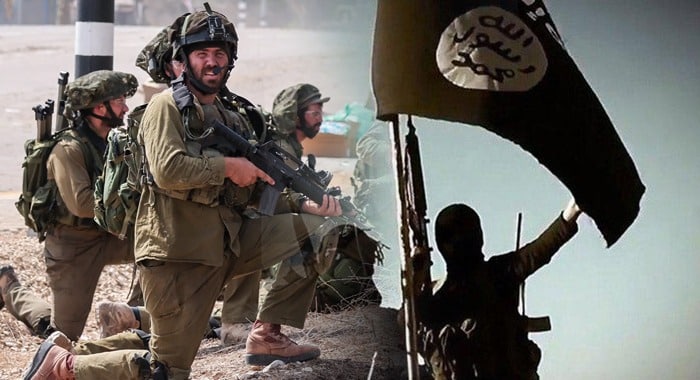In a world fractured by conflict and confusion, two of the most notorious actors on the global stage Israel and ISIS are often seen as bitter foes, ideological opposites, and irreconcilable adversaries. Yet a deeper, more unflinching analysis reveals a starkly different reality. These entities, despite their contrasting facades, operate in disturbing harmony, advancing a shared legacy of destabilization, sectarianism, and subjugation within the Islamic world. At their core, both serve as enforcers of a larger imperial strategy centered in the West, particularly in Washington.
The Israeli state’s decades-long campaign of repression against the Palestinian people is no longer a hidden injustice. Gaza has become a graveyard of innocent lives, reduced to rubble by sustained bombardments and blockades. But Israel’s cruelty has not evolved in isolation; it is the product of systematic backing from the United States and other Western powers who have financed, armed, and diplomatically protected this settler-colonial regime at every turn. Through this alliance, Israel not only maintains military dominance but also operates an expansive intelligence network designed to shape events across the Muslim world.
This is where ISIS enters the equation—not as a rebel force resisting the status quo, but as an instrument carefully inserted into Muslim societies to dismantle them from within. The group’s calculated destruction of Muslim communities, its relentless targeting of Shia minorities, and its erasure of historical religious institutions point to an agenda that benefits no one more than the enemies of Islamic unity. Like Israel, ISIS thrives on sectarian fault lines, exploiting them to ignite internal conflicts and divert attention from the real oppressor.
Striking parallels can be drawn between the operational behaviors of the two. Both entities utilize terror as a central tactic. Both deliberately attack civilians. And both pursue a brand of violence that transcends military objectives, aiming instead to terrorize, destabilize, and dominate. Where Israel uses state power to crush resistance movements, ISIS masquerades as a religious movement while destroying the very foundations of the faith it claims to defend.
More disturbingly, their paths intersect not only in strategy but in origin stories. Evidence points to a disturbing pattern of foreign intelligence involvement in the birth and evolution of ISIS. From training and recruitment to ideological grooming, certain academic and policy institutions in the West—and even within Israel—have played a role in shaping the group’s leadership and propaganda. Western universities operating in Islamic nations often act as soft-power channels for such ideological engineering, lending legitimacy to individuals who later emerge as voices of controlled dissent.
Throughout the wars in Iraq and Syria, ISIS seemed to operate with a puzzling degree of impunity, navigating regions supposedly under heavy surveillance by American and allied forces. In Afghanistan, credible reports indicate that the group at times enjoyed proximity to U.S. military zones—raising questions about the selective visibility of its operations and the international networks that sustained it. These inconsistencies are not anomalies; they are symptoms of a covert partnership designed to weaponize chaos.
The silence of ISIS during pivotal moments in the Israeli-Palestinian conflict further unmasks its true function. While claiming to defend Islam, the group has never once lifted arms against Israeli forces or shown solidarity with Gaza’s besieged population. Despite its presence in neighboring regions such as Syria, Iraq, and Jordan, ISIS has consistently avoided engagement with Israel. Instead, its media affiliates have, on occasion, echoed anti-Iranian rhetoric that aligns neatly with Tel Aviv’s strategic interests.
This convergence is neither accidental nor trivial. It reflects a division of labor in the architecture of Western power projection: Israel operates as a formal ally, its actions defended in international forums; ISIS plays the role of a manufactured enemy, its violence used to justify foreign intervention, surveillance, and the further militarization of Muslim lands. Both serve to delegitimize Islamic resistance and distort the image of Islam globally—one through bombs and occupations, the other through ideological sabotage.
Even in their posture toward the West, Israel and ISIS show remarkable similarity. Israel remains the United States’ most steadfast ally in the Middle East, and ISIS—despite its anti-Western slogans—has rarely targeted Western interests in any meaningful or sustained way. It continues to recruit from Western countries, often without serious obstruction, and its narrative, however brutal, is frequently amplified in global media. This tolerance betrays a deeper complicity, where the appearance of conflict masks a quiet coordination.
The Islamic Emirate’s experience in Afghanistan offers a rare example of this illusion being shattered. On multiple occasions, Taliban forces have dismantled ISIS strongholds, revealing their foreign backing and exposing the ideological fraudulence behind their self-proclaimed jihad. Captured operatives have confessed to missions rooted not in theology but in manipulation and misinformation.
What emerges from all this is not a clash of civilizations, but a convergence of agendas. Both Israel and ISIS are tools of disruption, working in tandem—knowingly or otherwise—to prevent the emergence of a unified, independent, and sovereign Muslim world. Their violence, however different in style, springs from the same source: an imperial desire to control Muslim futures through fragmentation and fear.
To recognize this alignment is not merely an academic exercise—it is a strategic necessity. For too long, Muslim societies have fought the fires of extremism and occupation separately, failing to see the coordinated hand behind both. The time has come to connect the dots and challenge the imperial designs not only through resistance, but through clarity and unity.





